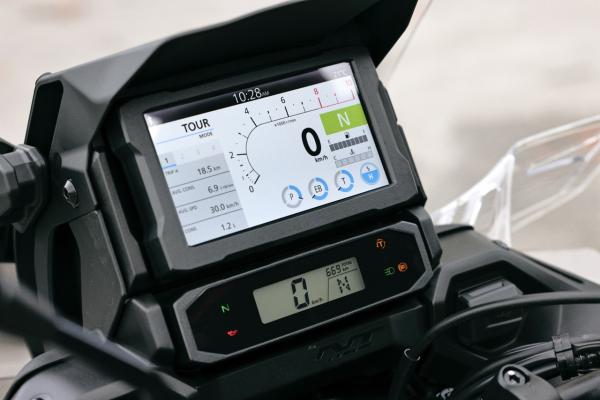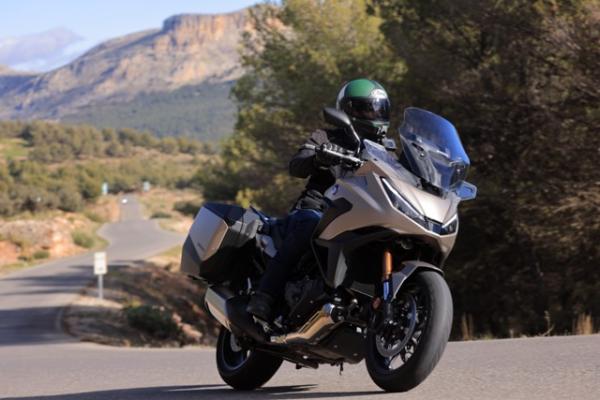The updated 2025 Honda NT1100 embodies the ethos of omotenashi, apparently. For the uninitiated (which included me until it was uttered at a presentation before the launch ride in Spain), omotenashi doesn’t directly translate to a single word in English, but rather, it’s all about a feeling of hospitality and mindfulness, and is closely associated with the hosting of the Japanese tea ceremony. Right.
Linking that to riding a motorcycle seems a bit of a stretch, but I can see what they’re getting at. The NT1100 is a bike that’ll look after you, and whisk you to your destination in about as much comfort as is possible for something on two wheels. And thanks to a raft of changes, it should be better than ever at completing that task.
To suss out the effectiveness of the changes, I rode the bike in DCT form with the electronic suspension specced at the international launch in southern Spain.
Price, colours and availability
The base model NT1100 (manual gearbox) will be available in the UK for £12,679, making it the same price as the previous model year version. Likewise, the NT1100 DCT will cost no more than previously at £13.679. The new flagship model in the range, the NT1100 DCT Electronic Suspension, will be landing in UK dealers with a list price of £14,099, meaning the trick Showa suspension upgrade is only a £420 premium.
Looking at the competition, the closest to the top-spec NT from Yamaha comes in the form of the Tracer 9 GT which commands a price of £13,216. The £15,569 Kawasaki Versys 1000 SE could also be looked at as a competitor to the new top-spec NT, although with more power than the Honda, its slightly higher price seems justified.
The bikes are expected to be in UK dealerships in the new year (hopefully around January) and each variant of the bike will be available in either Mat Warm Ash Metallic, Gunmetal Black Metallic, and Pearl Hawkseye Blue, each of which is a new colour for 2025.
What’s new with the 2025 NT1100
Starting with the engine of the bike, which is the same across the range, the 1,084cc parallel twin-cylinder unit now features a new larger 33mm intake ducts, and intake trumpets that are 65mm longer than before. The NT1100 also features a revised combustion chamber and a new exhaust system, as well as updates to the ECU to suit the revised engine.
The updates are responsible for boosting low and mid-range torque by a claimed seven per cent without sacrificing any peak power – a claimed 100bhp at 7,500rpm. Peak torque is also claimed to have increased, from the 76lb ft of the 2024 bike up to 82lb ft of the new machine. Peak torque is also achieved slightly lower in the rev range arriving at 5,500rpm on the 2025 model, not the 6,250rpm of the 2024 model.
The bore and stroke of the Africa Twin-derived engine are the same as before (92mm with an 81.5mm stroke) although the changes to the combustion chamber have raised the compression ratio slightly, taking it from 10.1:1 to 10.5:1. As before, there’s a 270-degree crankshaft to give an offset firing order.
As before, riders can either choose fully automated shifting or button-operated shifting via the paddles on the left handlebar. Shifting schedules for automatic mode remain as D, the most economical, and S which has three levels to choose from – with three being the most sporty and aggressive.
Along with the electronic and mechanical updates for this year, the NT1100 will also feature revised styling, headlined by a new fairing which is partially constructed from a bio-degradable material called Durabio. The front fairing is said to give the 2025 bike a ‘smaller, sleeker ‘face’’, while the tail unit has also been tweaked. Nestling on top of the redesigned fairing is a revised screen, which features 167mm of adjustment through five steps. Rounding out the new bodywork is a 150mm longer front mudguard for improved weather protection.
One welcome addition to the new model is the revised indicators which are now incorporated in the headlights, and not on their own stalks as was previously the case. The positioning of the indicators on the outgoing model meant the positioning lights would reflect in the fairing-mounted wind deflectors which could be a little distracting, hopefully mounting them within the projector headlight (which also features a DRL) should cure that issue.
Another upgrade for 2025 is the inclusion of larger panniers that are claimed to be large enough to stow a full-face helmet within. The new boxes are 25mm deeper than before, yet still mount to the existing fixing system, and now boast 37 litres on the left and 36 litres on the right, up from 33 and 32 litres provided by the outgoing machine.
New Showa EERA for 2025
Probably the most headline-grabbing update to the NT1100 for 2025 is the inclusion of the new DCT Electronic Suspension version of the bike. Like the existing Africa Twin ES models, the new top-spec NT’ gains the Showa Electronically Equipped Ride Adjustment (EERA) system.
Equipped with settings specifically developed for the NT1100, the system automatically adjusts the damping based on information from the ECU, the IMU and a stroke sensor. The system is claimed to adjust the suspension just 15 milliseconds after the calculations are completed. Because of this, the Showa system can automatically tweak the suspension of the bike in line with how the machine is being ridden, firming the damping as the speed increases and softening it once the speed reduces.
There are three pre-determined suspension modes, Urban, Tour, and Rain, along with a User mode that allows the rider to choose their own remound damping and preload setting. On top of this, the EERA allows the rider to adjust the rear preload of the bike through 24 steps while on the move, regardless of which suspension mode the bike is in.
What’s it like to ride?
Perhaps the most useful part of the whole press ride wasn’t on the 2025 version of the bike, rather, one on 2024 machine that tagged along with the group. A ride back to back with the new one highlighted just how good that new electronic suspension is. The ride is noticeably busier on the 2024 NT1100, even on reasonably smooth Spanish asphalt.
Switch to the 2025 bike, and suddenly everything is ironed out and just shrugged off. Yes, in the hard suspension setting you can still get bounced out of the seat when tackling particularly rough bits of road, but the comfort and composure are still better than on the passive-damped bike. It never crashes through its travel.
The medium mode is, perhaps unsurprisingly, probably your best bet for most situations, and works nicely when combined with a bit of extra preload at the rear. The NT doesn’t become wallowy in the soft setting, but there’s noticeably more brake dive.
Meanwhile, the engine tweaks result in a parallel twin that seems more eager and refined, although it still feels like a bit of a workhorse, especially compared to Honda’s higher-revving twin found in the XL750 Transalp and CB750 Hornet. It’s gutsy, but not the most exciting. Admittedly, the DCT might well be sapping a bit of fun out of it – slick though the gearbox is – and you do start to warm to the engine when using the shifters on the left-hand switch cube, deciding yourself when exactly you want to buzz up to the redline or short-shift.
In sport mode, I never quite felt like I agreed with the shifts the gearbox was making, particularly in the S3 mode in which the bike is too keen to hang onto gears. This leaves the revs sitting annoyingly high long after you’ve calmed down to cruise through the village rudely interrupting your twisty road fun. S2 is a better balance, but still, I found myself wanting to partake in some manual intervention.
It’s smoother and more consistent off the line thanks to the nerdy DCT changes, though, and for cruising around normally in D, it’s ideal, with a quiet brilliance to the way it seamlessly shuffles ratios. At that point, you forget all about it, which is the biggest compliment you can pay to a system like this – you’d only be noticing it if it was doing annoying things.
And cruising is generally where the NT1100 excels. Yes, it can do the twisty stuff, and much better than you might expect. In fact, much of the route involved winding mountain roads, and up to a point, the NT hides its near 250kg bulk quite well. As soon as things get tighter and more nadgery, though, it starts to feel a little unwieldy, and more pronounced steering inputs are needed to get the thing turned.
It also feels as though the foot positioning could be further tweaked. Several times I had my boots brushing the floor when heavily leant over, and I wasn’t the only rider to experience the same on the launch.
The new screen is far easier to adjust than the old one, which required you to get off the bike, grasp it with two hands and wrench it up or down in a way that made you wonder if you were going to break the damn thing. The new setup is a little fiddly, but can be done on the move easily enough. I found myself running the screen at half extension, though. When up as high as it’ll go I experienced a helmet-wobbling turbulence at anything over about 50mph. Admittedly, I am six-and-a-bit feet tall and a lot of motorcycle screens aren’t much use to me – if you’re a bit shorter, you’ll be better cocooned.
Something that hasn’t changed is the design of the left-hand switch cube, and it remains spectacularly busy, a bit ugly, and difficult to get your head around initially. In time, I’m sure you’d get used to it, but when so many other positive changes have been made, it seems a shame this bit of the bike has been left as is. It’s also worth pointing out the USB socket is of the A variety, which is fast becoming old fashioned. At this point, though, we’re splitting hairs.
Should you buy a 2025 Honda NT1100?
Look, I’m not going to judge those who buy an adventure bike for touring, and then never take the thing off road. It happens enough in the car world with people buying high-riding SUVs, with the closest thing they do to off-roading being parking up in a gravel car park.
And yet, a more traditional tourer like the NT1100 is going to better serve a lot of these riders who are eying up ADVs, Honda’s own (and NT-related) Africa Twin included. They’re great bikes for munching miles, but to borrow from that pre-ride presentation again, just not quite so omotenashi.
There are, though, touring bikes that’ll be more fun at the mountainous destination of your tour while barely any less comfortable on the way there, for instance, the Yamaha Tracer 9. The NT1100 is perfectly competent and does all it needs to, arguably going a little beyond that point, especially given that Honda calls it a ‘tourer’ and refuses to stick the word ‘sports’ before it.
The changes make the bike more appealing than ever. What’s more, it’s still excellent value, and if you’re already looking at a DCT-equipped bike (two-thirds of NT1100 buyers go for the auto), it’s such a small jump to spec the electronic suspension that it seems like a no-brainer.

.jpg)












